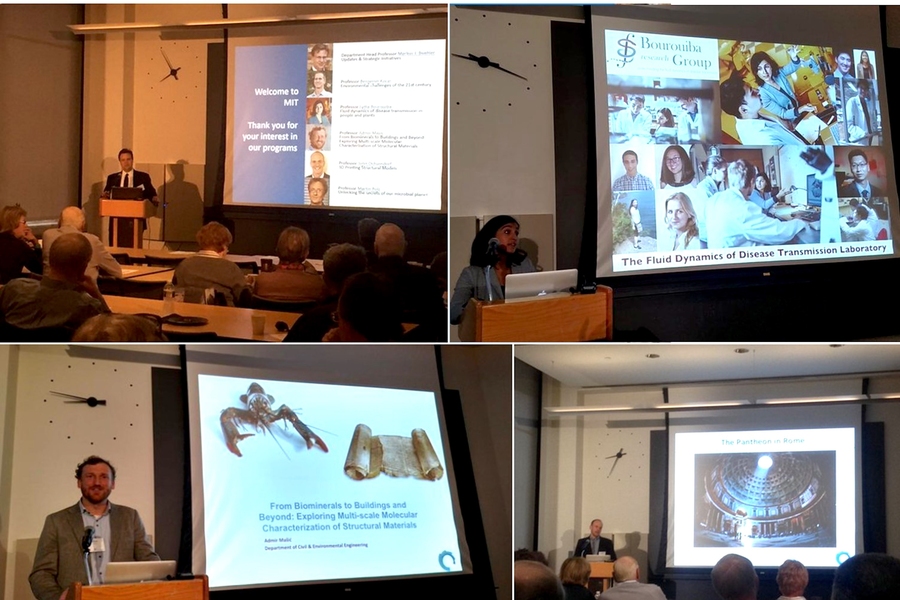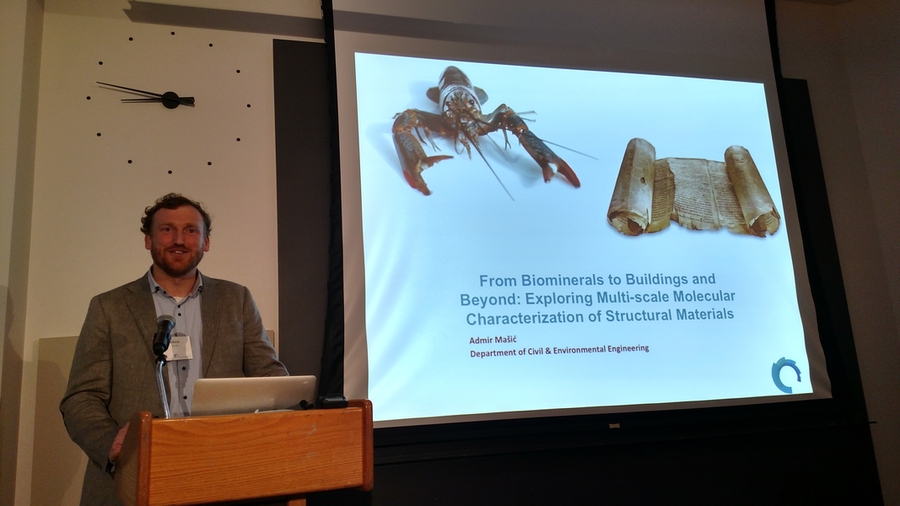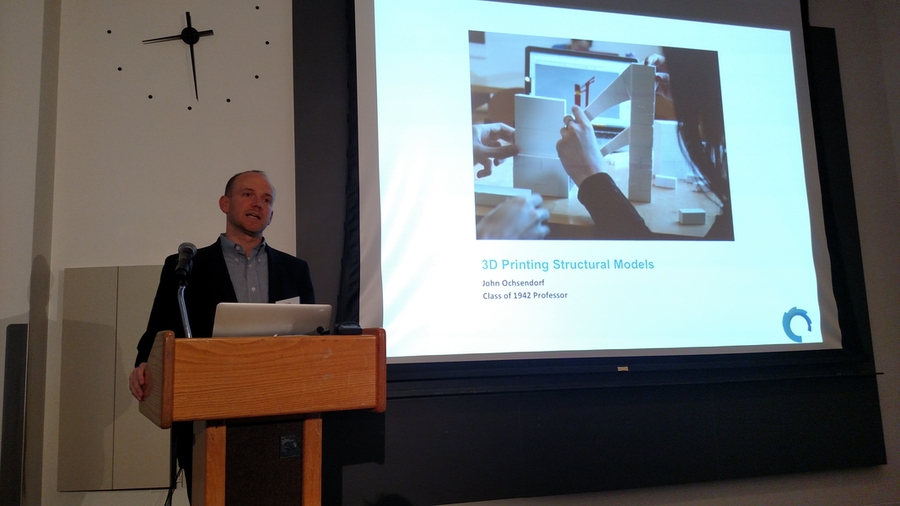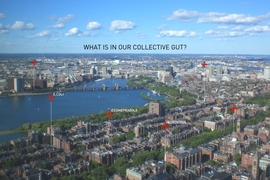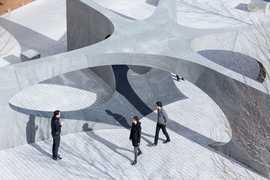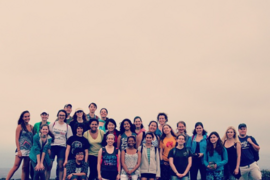On Oct. 21, alumni, students, faculty, and staff from the department of Civil and Environmental Engineering (CEE) gathered for the department’s third annual CEE New Research Alumni Breakfast.
In recognition of this year’s theme — Environment, Infrastructure, and People — department head Markus J. Buehler, the McAfee Professor of Engineering, opened the breakfast with a review of some of the grand challenges present in society and the steps CEE is taking to solve them.
Buehler, whose own research centers on infusing the mechanics of natural and biological materials in the design of more resilient human-made systems at the interface between the natural and the built world, iterated his fundamental vision for CEE and the department’s overall progression over the past year.
“Our faculty have made remarkable progress in redesigning, redeveloping, and reimagining our graduate and undergraduate programs,” he said. “The education of our students, and offering significant opportunities for them to realize their aspirations, is the most important mission of the department.” Other topics covered in his opening remarks included new faculty hires, laboratory renovations, involvement in Institute and interdepartmental initiatives, and upcoming events.
In particular, Buehler emphasized CEE’s core of “big engineering,” using science to make small-scale change with big-scale impacts — a term that represents the ambitious platform of innovation that the department embraces. “The MIT CEE department is leading society into an era that fosters a new understanding of the environment, how we are irreversibly changing the natural world, and defining how we can further humanity’s progress by discovering the principles of opportunity that fuel new growth.”
Five other CEE faculty gave short presentations at the breakfast on their particular research interests and the work being done in their labs.
Environmental challenges of the 21st century
Growing up in rural Washington, Assistant Professor Ben Kocar says he naturally has a deeply rooted interest in the study of environmental processes.
A biogeochemist studying how elements cycle through ecosystems, Kocar spoke about a myriad of environmental challenges including soil quality in relation to agriculture, the maintenance of water resources, and the conservation of energy.
“We need to have an understanding of what processes are happening in soils at the microscale,” he said. Kocar and his group of students study soil interactions in order to holistically comprehend the specific impacts to elements at the microscale and how those processes can scale up.
Kocar emphasized one particular remediation strategy used to extract a particle of uranium from groundwater for a more detailed analysis of its cycling process. Application of this technique has potential benefits in natural systems, such as for studying how arsenic in Southeast Asia is partitioning into solution and infiltrating its groundwater.
He and his group, Kocar adds, are working to study chemistry on a more comprehensive level and ultimately tease out the seemingly invisible processes occurring that deeply impact the environment.
3-D printing structural models
“The world has analytical thinkers — engineers who can solve problems once the problems are defined — and synthetic thinkers — those who are creative and interested in big picture challenges. [CEE] strives to create students and graduates who think both ways,” said Professor John Ochsendorf of CEE and the Department of Architecture.
Poised between the two departments, Ochsendorf works in the sector of structural engineering with particular research focuses on structural design, masonry mechanics, engineering history, and sustainability.
The world, said Ochsendorf, is urbanizing at an incredibly fast rate and, in an age of climate change and concern about resource scarcity, is in “desperate need” of civil engineers to design buildings using less material.
Ochsendorf and his group use laser-scans of buildings to capture the building’s geometry, cut that geometry into smaller blocks, and 3-D print the blocks to a high accuracy. The students can then study the limits of stability of existing buildings — the Pantheon in Rome and the Sean Collier Memorial on MIT campus being the two examples he provided — using these 3-D printed models.
Ochsendorf, along with his roles as a housemaster on campus and chair of the committee for the upcoming MIT celebration of 100 years since its move to Cambridge, also co-leads the CEE Master of Engineering (MEng) program.
From biominerals to buildings and beyond
Assistant Professor Admir Masic, a new hire in CEE with a passion for chemistry and math, described in his presentation his mission to merge real-world exploration with in-depth lab analysis in his teaching.
“I am excited about contributing to the CEE TREX [Traveling Research Environmental Experience] program,” Masic said. He envisions for this program an in-field, mobile lab to accompany students in the real world. Using handheld lab tools to explore structures in the natural environments, Masic explains the students would take this tangible research back to MIT and further examine using sophisticated microscopes that monitor the interactions of molecules at the nanoscale.
This approach, he said, will help to uncover new insights in the prevention of material degradation as well as stimulate future structural innovations and material design.
Masic’s research interests reside in the exploration of construction materials, infrastructure and historical buildings to innovate new materials, and to understand the long-term behavior of materials such as those used to construct our bridges and roads.
The antibiotic resistance problem
Professor Martin Polz studies environmental microbiology with a particular focus in the assessment of structure-function relationships in microbial communities.
“We live on a microbial planet,” Polz said to open his presentation at the alumni breakfast. “You consume bacteria all the time and what this tells us is that almost no bacteria in the environment are pathogens.” On the contrary, Polz says these microbes play important roles in keeping humans and the planet healthy.
Polz continued to his heart of his presentation: the use of antibiotics in society, particularly agriculture, their side effects, and how their overuse has caused a crisis of widespread resistance of pathogens. Can antibiotics, he posits, be replaced with something equally effective and with far fewer unwanted effects?
Surprisingly, he said, the answer may lie in exploring the natural dynamics of bacterial populations in the wild.
According to Polz, if nature can be screened and a cocktail of different viruses collected that only affect one specific bacteria population, the rate of resistance buildup could be hindered during the progression of disease.
The fluid dynamics of disease transmission
Lydia Bourouiba, the Esther and Harold E. Edgerton Assistant Professor in CEE, spoke at the breakfast about her work combining fluid mechanics and epidemiology to analyze the mechanisms of infectious disease transmission.
Bourouiba and her group have set out to elucidate fundamental questions of infectious disease spread, extract and rationalize the essence of mechanisms governing the dynamics of pathogens transport that sustains and shape infection spread from host to host. In her talk, Bourouiba showed high-speed visualizations of fluid fragmentation processes such as sneezes — a common way of transmitting respiratory diseases. This unique approach, a combination of fundamental theoretical modeling and fluid dynamics experiments, provides deeper insights into the range of contamination for various transmission processes. For example, it allows to understand how a sneeze can contaminate indoor environments and under which conditions.
This approach, she says, can allow for mechanistic understanding and modeling of the dynamics of infection transmission to shape more effective and targeted strategies for the mitigation of epidemic spread.
“Public health agencies are in need of more quantitative approaches to evaluate risks of contamination and protect front-line health-care workers in epidemic settings,” Bourouiba said. Her work stems from a vision to root public health policies for disease control in fundamental mechanistic sciences.
The department, said Buehler, holds a “unique position in the crossing of science, engineering, infrastructure and the environment that enables significant impact.” The future of CEE is truly exciting and the members of the department community are helping to build a group capable of addressing some of today’s greatest challenges, he concluded.
